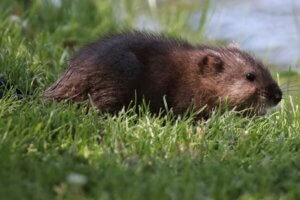Have you ever seen a small, furry, brown creature on the side of Bob’s Pond or swimming in Bob’s Pond at Hudson Gardens?
Commonly mistaken for a beaver, muskrats also call Hudson Gardens home. Muskrats are much smaller than beavers and have a tail that resembles a rat tail, while beavers are much larger and have a wide, paddle-like tail.
Adult muskrats are about 16-25 inches long and weigh between 1.5-4 pounds. They are typically found in marshes, swamps, and wetlands because they do not tolerate dry heat very well and move more quickly in water than they do on land. They can hold their breath under water for 12-17 minutes and can swim about 3 mph. Musrats dig burrows on the banks of water and make lodges out of vegetation like cattails. Muskrats live in large social groups and are nocturnal but are often seen at different times of the day. Muskrats are voracious eaters and have a varying diet from vegetation, snails, salamanders, small birds, and even cannibalism under harsh conditions. At Hudson Gardens, the muskrats’ favorite food is our water lilies. Muskrats usually don’t travel farther than 150 feet from their homes when searching for food.
We have fondly named the muskrat we see Harry the Muskrat. We hope you will have the opportunity to see Harry hanging out on the banks or taking a nice swim in the pond.
Bradford, Alina. “Facts About Muskrats”. LiveScience. 2017



